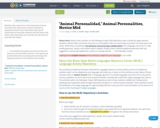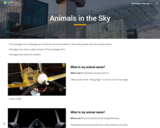
Are animals intelligent? What is intelligence? How can you tell, whether animals are intelligent?
- Subject:
- Education
- Elementary Education
- Life Science
- Zoology
- Material Type:
- Primary Source
- Date Added:
- 09/10/2018

Are animals intelligent? What is intelligence? How can you tell, whether animals are intelligent?

Students will read an article on animals. Using the provided worksheet students will take notes on an animal of their choosing. Once they have taken notes, they will be asked to write a new report on their animal.

Students will read an article on animals. Using the provided worksheet students will take notes on an animal of their choosing. Once they have taken notes, they will be asked to write a new report on their animal.

Students will use pictures to determine the emotions that others feel. Afterwards, students will take an animal personality test to determine what type of animal they are most like. Students will then share with others what animal they are most like and why they are most like that animal.

Students listen to fiction and nonfiction read-alouds and explore selected Websites to identify factual information about animals. This lesson focuses on ants, but can be adapted to any animal.

Learn about the structure and function of living organisms by drawing an imaginary animal in the Take the Stage game show, ANIMAL SURVIVAL! Viewers become contestants on a game show and are challenged to draw an imaginary animal that could live and survive in either the desert, ocean, or the arctic tundra. When drawing the imaginary animal, the contestants write out two distinct structures and a function for each of the structures that help it survive. Learning Objective: Compare the structures and functions of different species that help them live and survive in a specific environment.

Students will explore the outdoor classroom in pairs looking for evidence of animal life and imagining what types of animals might live in, and survive in, the outdoor classroom area.

Learn about the physical characteristics of environments and act out the animals that live there!
You are the next contestant on the Take the Stage game show ANIMAL SURVIVAL where you will travel in a hot air balloon to the forest of North America, the savanna of Africa, and then take a submarine ride underwater in the ocean. To play the game, you will act out an animal that would live in each environment, and then write how the physical characteristics of each environment helps your animal survive.
Learning Objective: observe and describe the physical characteristics of environments and how they support populations and communities of plants and animals within an ecosystem.

Subject/Course: English
Topic / Unit: Animals
Grade: 3
Duration: 10 minutes
Lesson Objectives: Students will be able to recognize the names of animals.
Materials/Resources: Canva presentation

This book provides an overview of the current debates about the nature and extent of our moral obligations to animals. Which, if any, uses of animals are morally wrong, which are morally permissible (i.e., not wrong) and why? What, if any, moral obligations do we, individually and as a society (and a global community), have towards animals and why? How should animals be treated? Why?
We will explore the most influential and most developed answers to these questions – given by philosophers, scientists, and animal advocates and their critics – to try to determine which positions are supported by the best moral reasons.

Hibernation is an ingenious adaptation that some animals employ to survive difficult conditions in winter. This unit examines the differences between hibernation and torpor, and discusses the characteristic signs of hibernation behavior It explores the triggers that bring on hibernation, and whether internal signals or external season cues are predominant. It also examines the physiological adaptations that occur in hibernating animals.

The extreme challenges of life in the polar regions require the animals who make their habitat there to make many adaptations. This unit explores the polar climate and how animals like reindeer, polar bears, penguins, sea life and even humans manage to survive there. It looks at the adaptations to physiological proceses, the environmental effects on diet, activity and fecundity, and contrasts the strategies of aquatic and land-based animals in surviving in this extreme habitat. This unit builds on and develops ideas from two other 'Animals at the extreme' units: The desert environment (S324_1) and Hibernation and torpor (S324_2).

Animal life has adapted to survive in the most unlikely and inhospitable habitats. This unit looks at the surprisingly diverse desert climates throughout the world and mammals, birds, lizards and amphibians that survive there. It splits these animals into three groups according to their strategy for survival: evaders, evaporators and endurers, then discusses how these strategies work on a biochemical and physiological level.

This digital scavenger hunt challenges you to find aircraft at the Steven F. Udvar-Hazy Center that have animal names.

This paper version of our popular scavenger hunt challenges you to find aircraft at the Steven F. Udvar-Hazy Center that have animal names.

Students will read and observer ants to discover how ants are the same and different than people.

Digital Dialects offers vocabulary games in multiple languages. For Arabic, there are five different vocabulary games: numbers 1 Đ 12, numbers 10 Đ 100, animals, colors, and numbers: Arabic script. Their Arabic offerings are all in transliteration without any Arabic script, with the exception of the numbers 1 Đ 12, which has two separate games for both.

The purpose of this resource is to observe when selected bird species first arrive at your study site, and to count the numbers until few or none of these birds are seen. Students select a common and easily identifiable bird species in their region and observe when the bird species first arrives. Students use binoculars or telescopes to scan a study site and count how many they see. They continue to observe every other day until few or none of the selected species can be seen.

See the many birds that spend their summer in the Arctic in this video segment from Nature.

Contains Third Grade Association Triangles Overview and four examples of student work